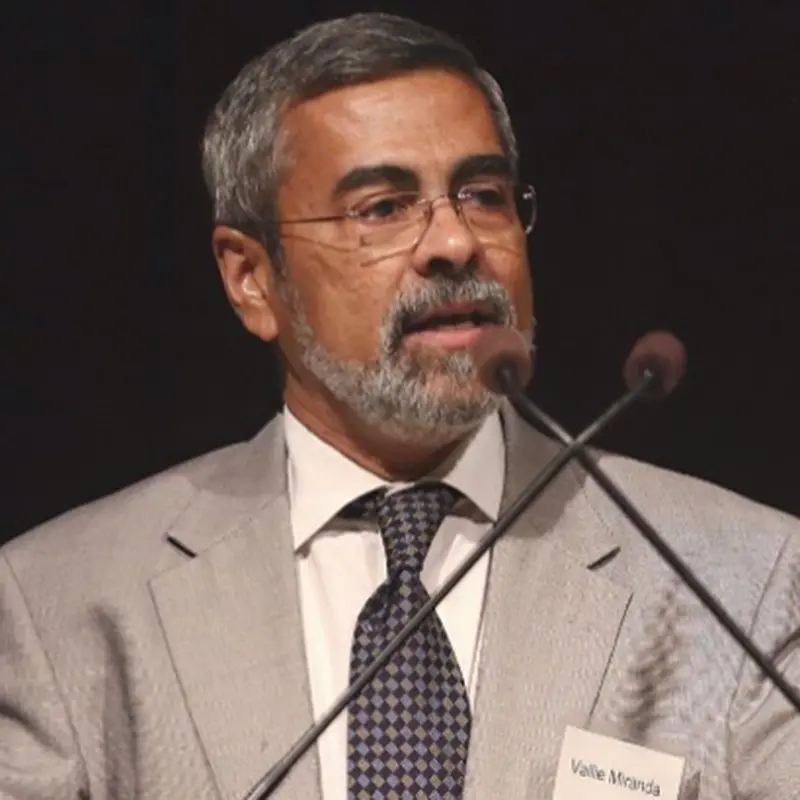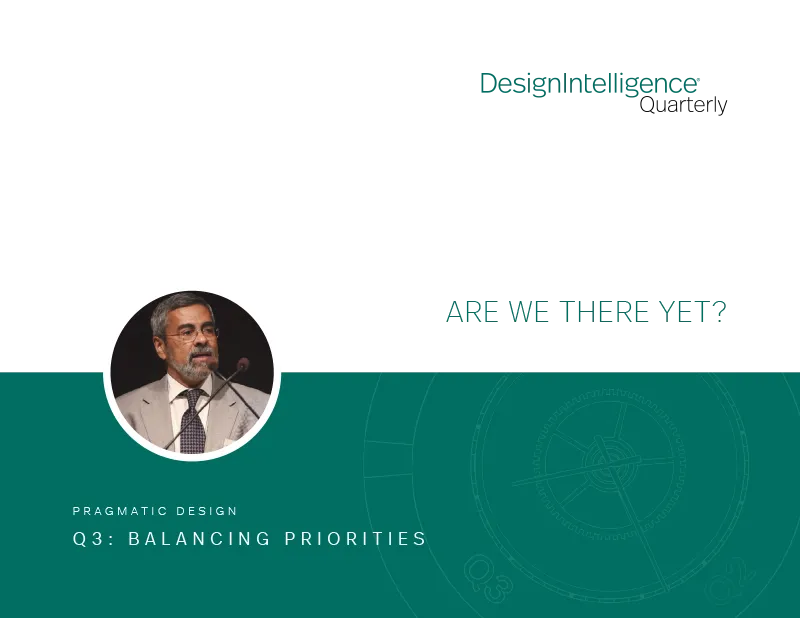Are We There Yet?
by Valerian Miranda, PhD, FAIA
August 23, 2023
Valerian Miranda examines the changing priorities and relationship of the academy and the practice of architecture
Provocation
At a recent Design Futures Council summit, presenters comprised a representative mix of architectural academics and practitioners. In that event, several practitioners reacted with vocal consternation to a provocative suggestion by a national figure in architectural education:
“The sole purpose of architecture schools is not to train students for practice.”
While the suggestion was timely, the resulting consternation was equally understandable. More importantly, the exchange and subsequent discussion highlighted a host of complex issues confronting current architectural academia and practice.
These days, architectural practices range from sole practitioners geographically focused on a single town to multi-thousand-employee, worldwide firms. Commensurately, project budgets and scopes vary from well under one hundred thousand dollars to well over one hundred million dollars. As a result, practitioners have different expectations around the essential knowledge and capabilities of graduates of accredited programs.
To further frame the discussion, consider that 125+ accredited architecture programs currently offer professional degrees that range from 150-credit Bachelor of Architecture degrees through several Master of Architecture degree options to 210-credit Doctor of Architecture degrees. These programs are housed in a variety of institution types, from mammoth, research-intensive (R1) universities to single-unit specialty schools. One could easily visualize that this difference will affect funding levels, technological resources and other aspects. It follows that qualifications and performance expectations for faculty members at these institutions will differ considerably. All this despite the architectural profession’s ever-present need for a level of uniformity in the minimum capabilities of students graduating with accredited degrees to support consistent standards of care in practice.
Exacerbating these inequalities is the existence of no less than 55 architectural licensing jurisdictions, many with different requirements. In the U.S., a country that has just one architect for about every 3,000 citizens (a low rank among developed countries), we still do not require an architect’s services for a sizable portion of our non-infrastructure construction.
An Expansion of the Profession
Given the realities outlined above, and the fact that architecture billings are not growing at a rate commensurate with the growth of relevant spending on construction, rehabilitation, operation and management of the built environment, it is reasonable to suggest that a change in approach is due. One such plausible new direction is to consider expanding the traditional notion of architectural services to encompass other revenue-generating functions serving societal needs in designing, managing and experiencing the built environment.
Articulating the value of these services (beyond traditional ROI) and their broader societal benefits and implications may be an appropriate next step. A few leading firms and schools have already begun to move in this direction and are investing the resources to catalyze such developments.

The conversations and debates will continue, with no near-term agreement in view. And such a dialogue is positive! Beneficial change in architectural practice will likely be achieved with more speed, effectiveness and flexibility than can be currently achieved in academia because practice is free of the disciplinary and provincial baggage of the past and subject to the urgencies of life. Our more inclusive and connected society now demands services that will determine market demand and will self-select areas of emphasis and specialization in education. The profession of architecture – and the architectural academy that supports it – must change quickly, because in these fast-moving, fluid times, allied professions and fields are not waiting around to follow our lead. Beyond just encroaching, they are invading.
A couple years ago, at an academic conference, I overheard a discussion related to “where is the most appropriate place in the curriculum to introduce digital technology?” Really? Change in academia invariably requires the sacrifice of sacred idols. We’ve seen this movie before, over the two decades it took for digital media to become the norm. To succeed, the digital revolution had to contend with many personnel retirements, positions that could be replaced with more current and relevant expertise, along with concomitant changes in design process.
Curriculum Change Opportunities
In that conference, a cursory examination of a large sample of schools offering accredited degrees in architecture identified areas for change that could be generalized. These schools were not a random sample, since obvious outliers were excluded in advance. Common areas identified as offering potential included: curriculum, facilities, faculty, expertise and resources. In fairness, it should be stated that current conditions for accreditation (which are regularly revised) are comprehensive and not prescriptive. They typically include required coursework in program criteria, student criteria and a self-assessment.
In all examples of the required curriculum examined, it was difficult to find any courses or content considered superfluous or unnecessary. Yet these curricula overwhelmingly did not include content that would contribute to more relevant future knowledge and capabilities. Typically, required courses occupy so much of the curriculum that there is insufficient time and space for elective courses. This is true particularly in allied disciplines, which are arguably increasingly relevant to a student’s future in a changing world. Clearly, the importance of several “sacred” courses must be prioritized and reexamined for content and delivery method. Too much of current architectural education relies on outdated models such as the “sage on the stage” and the “studio master knows all.”
The world simply doesn’t work that way anymore.

Research Emphasis
Professional education now relies more heavily on research as a way of advancing knowledge and fostering innovation than ever before. This renewed emphasis on research is a culture that leading institutions are encouraging through design studios. Flipping through pages on the internet or doing Google searches and copying information does not constitute research! Such activities are mere information searches, scarcely more rigorous than the average layperson’s scrolling for the latest Kardashian news. Hypothesizing, analyzing, concluding and documenting are all essential components of rigorous research that lend themselves to dissemination, replication and external review. They are also fast becoming essential components of design studios in schools around the world.
It is widely accepted that students are more knowledgeable and facile with digitally driven technologies than the current faculty in architecture schools. I shudder to think of the consequences of a similar situation in, say, medical education. There are several solutions, team teaching being just one, that can be used successfully. The notion issue that students should be encouraged and empowered to develop new skills remains vitally important but underserved.
Despite all the reliable tools that exist, it is not yet a priority that several aspects of design performance (beyond mere building energy use) are simulated to test their appropriateness and success in relation to alternatives. In other fields, simulation – in all its forms – is now a common component of any design endeavor. Sadly, in this regard, architecture remains the exception rather than an integral part of the emerging, higher-order rigor. Adding value through social and experiential relevance is a rapidly growing concept in several design and creative fields yet remains unattended in architectural pedagogy.
Elephants and Artificial Intelligence
Now, for the baby elephant in the room. Out of curiosity to see what an artificial intelligence platform might contribute to this article, I queried OpenAI’s ChatGPT to identify issues currently facing architectural education. In three seconds, I received the answer, organized in seven clear, succinct points. Point seven was:
“Pedagogical approaches: There is ongoing discussion about the pedagogical approaches used in architectural education. Some argue for a more hands-on, studio-based approach that emphasizes design exploration and experimentation, while others advocate for a more research-oriented approach that integrates theory and practice. Balancing these different approaches and finding the most effective teaching methods is an ongoing challenge.”
Reactions, Questions and Actions
I was gratified to see that AI did not infer that architectural education has the sole purpose of training students to serve practice. I was dismayed to see that the term “ethics” (near and dear to me) did not appear anywhere in the 450-word answer and could not be ascribed to any human source.
Collectively, we have much work to do and many questions to answer:
- Should we be encouraging students to lead the change?
- What is the role of practice in spearheading change?
- How do we inculcate values like ethics and empathy in design school curricula?
To weigh the repercussions of such questions and help us set priorities, it may be worth reexamining an often-quoted concept attributed to Bill Caudill, FAIA,1 who in the 1950s and ’60s
“ran his office 20% like a school and ran his school 20% like an office.”
In a world that is increasingly inclusive and connected, we would do well to direct our gaze inward and outward. Only through a synergistic, symbiotic view of practice and the academy will we chart a new path forward.
We are a long way from “being there” yet, but with empathy and awareness, adaptation and action, we can make it.
Valerian Miranda recently retired from Texas A&M University as the Wallie Scott Professor of Architectural Practice & Management and director of the CRS Center. He currently serves as adviser to the CRS Center, IPAL & AXP.
FOOTNOTES:
1 William Wayne Caudill, FAIA, 1985 AIA gold medalist, was a founder of the innovative, mid-century firm Caudill Rowlett Scott (CRS) and dean of architecture at Rice University.


